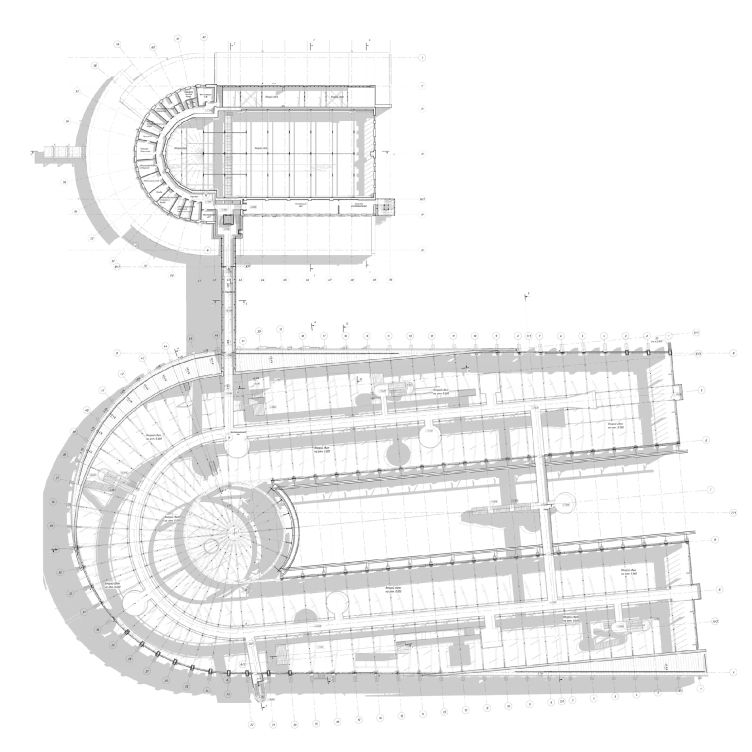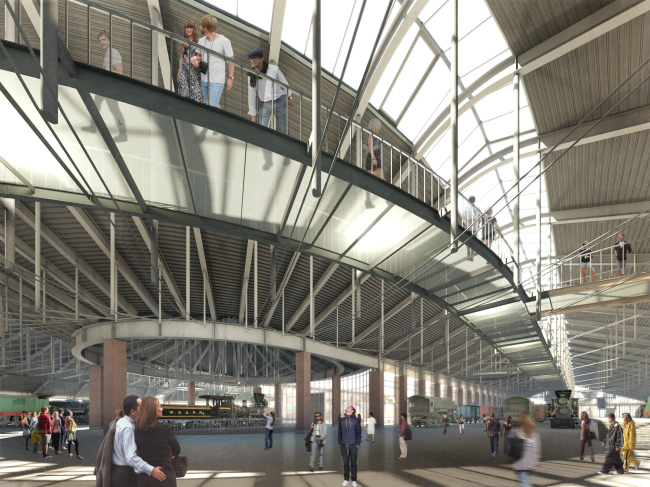
October Railway Central Museum © “Studio 44”
Saint Petersburg's October Railway Central Museum has been in existence since 1978, and is located at the Embankment of Bypass Channel, 114. After the closure of the Varshavsky ("Warsaw") Railway Station in 2001, the most bulky exhibits - more than a hundred steam engines, locomotives, and cars from Shushara Station (Pushkin District of Saint Petersburg) were moved closer to the existing building of the museum, i.e., onto the tracks of the former railway station. The city, however, suddenly had other plans for this territory. It is planned to build a residential neighborhood here, so the large family of engines needed a new home. And it was "Studio 44" that was invited to do this project.
Due to the fact that, for the normal existence of the collection of this museum, the railroad tracks are indispensable by definition, Saint Petersburg did not have too many options for its new location. Several stations in the central part of the city were considered but ultimately it was the Baltiysky Station that was picked out. The benefits of such a solution were obvious: the super-convenient location, the 100% thematic match and the availability of a great amount of free space. We are speaking here about the more-than-5-hectare area behind the Baltiysky Railway Station where now an engine house, a transformer substation, and a whole network of approach and dead-end lines are situated. It is planned that the engine house will be remodeled, while the existing lines will be "thinned out", made more scarce, generally "museumified", and again used as an "open-air showcase". Also, the track facilities, as the railway representatives say, will be later on used to accommodate the locomotion of retro trains. Still, first things first!
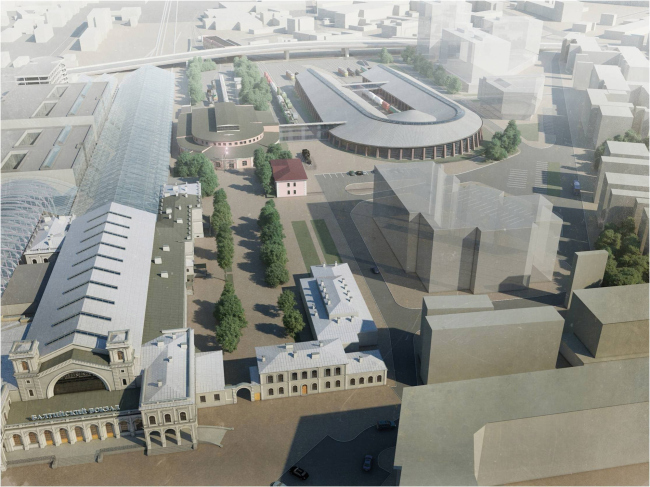
October Railway Central Museum © “Studio 44”
As Nikita Yavein explains, from the formal standpoint, the engine house is not a monument of architecture, and the architects did not need to necessarily keep it intact. However, for a railroad museum, one could hardly think of a more suitable and authentic volume, and this is why "Studio 44" did not for a minute doubt that the depot building WAS to be preserved. Moreover, it was this very building that predestined the compositional solution of the entire complex: its genre-classic "horseshoe" plan became the basis of the new expo facility. In fact, what the authors do is clone the existing volume making it about two and a half times as big and than dress it up into an ostentatiously modern shell.
The new building consists of three parts - the central nucleus with a radial layout structure, and two side wings. It is not by chance that the radial structure appears - the nucleus contains a turning-table for demonstrating the locomotive engines, and it is upon this pivot that the side wings of the building are mounted. What is peculiar is the fact that the latter are not parallel to one another but are placed at an angle of about 5 degrees, because of which the semicircular roof above the central part takes on a graceful careen - somewhat similar to the way that people pull down a wide-brimmed hat over their eyes on a sunny day. "This angle that we chose is equal to that of a railroad track switch - Nikita Yavein shares - It will let us to improve the view of the bulky exhibits, place the object at an angle to one another, and thus avoid the monotonous symmetry that would be boring for the visitors".
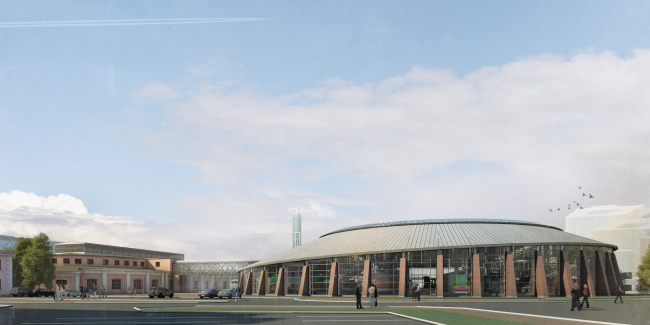
October Railway Central Museum © “Studio 44”
As was already said, being reminiscent of the historical depot in its form and structure, the new museum building considerably differs from its predecessor in its architecture. All that remains of the stone coating is the brutal-looking stone pylons with the space between them fully glazed. Through the giant stained glass windows, from the street one can perfectly see the turning-table and the fan of tracks running from it with the engines, as well as the sophisticated system of metallic girders that at once put one in the mind of railroad loading docks. At the same time, the architects leave the space between the two wings of the new building unstopped - it is decided this will be the place for the model of the historical railway station. "It seems to us that the life-sized station included into the museum is a very important part of the project - Nikita Yavein says - It pushes the limits of this traditional cultural institution and connects the immobile exposition with the operating infrastructure of the railroad".

October Railway Central Museum © “Studio 44”

October Railway Central Museum © “Studio 44”
It is planned that totally the new building and its courtyard will house some sixty-two exhibits of the rolling stock, while the remodeled depot will house 11 retro carriages and locomotive engines of the museum's collection. It is through the historical building that the entrance to the museum will be made through, so, the former depot will also get a lobby group, a café, and a souvenir shop, all of which can operate independently of the main exposition. It is planned that the new and the old buildings will be connected with overpasses of the first and the second level, which will give the visitors an opportunity to get exposed to the entire collection of the museum, and to its selected sections as well. For example, from the second level of the depot, one of its wings will be connected to the other with a hanging bridge, while the new building will be accessible though a covered gallery. Yet another bypass gallery is expecting the visitors in the newer building - along its inside perimeter, the architects run the so-called sightseeing route that will command an impressive view of the large exhibits down below.
The fact that the museum is moving over to the Baltiysky Railway Station does not at all mean that it will be located again at the outskirts of the city. Quite the other way around - today this territory is dynamically developing: several industrial parks located here are experiencing a period of integrated renovation. So, this two-building museum ensemble that develops the theme of continuity of historical stylistic devices and their modern interpretation will not only help to keep the spirit of the place but also will become a new "cultural beacon" of the forming public a business center of a city magnitude.

October Railway Central Museum © “Studio 44”
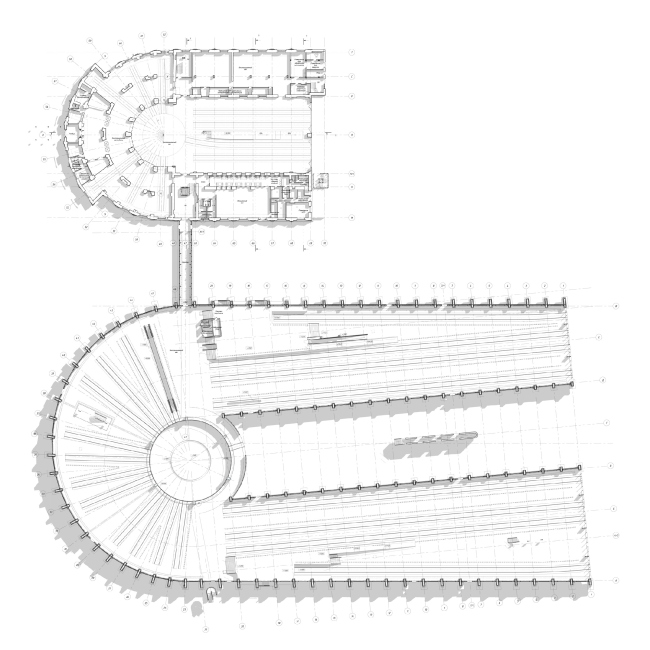
October Railway Central Museum © “Studio 44”

October Railway Central Museum © “Studio 44”
The Central Museum of the Oktyabrskaya Railway © Studio 44











